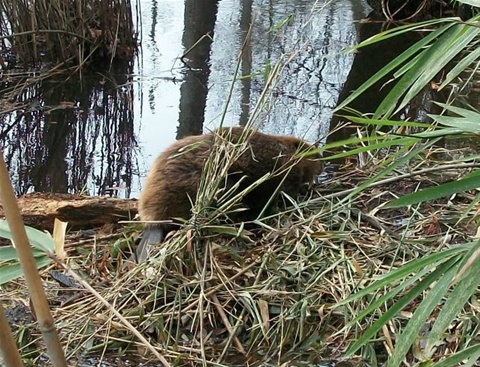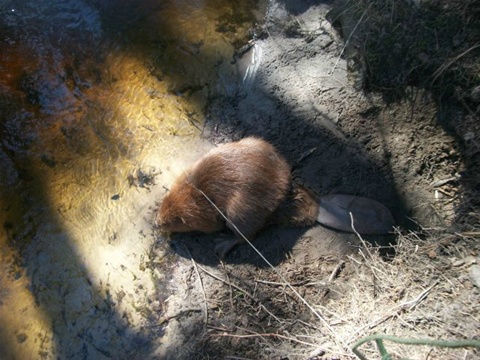Introducing, the North American Beaver.
With a temporary ban on trapping and an aggressive restoration program, this guy has made a strong comeback in North Carolina. They can be found on nearly every river, creek, swamp, and ditch line in our state. They average between 30 and 40 pounds but I have caught them as big as 86 pounds.
The family unit generally consist of the dominant male and female and their off spring for the past two seasons. Once the juveniles reach adulthood they will leave to find their own home and start a new colony or be driven off by their parents to make room for the next litter. One female will generally produce 2 to 4 new offspring each season. This means that the colony could consist of as many as 10 beaver at a time. But the numbers are usually closer to 5 to 7.
The beaver is the largest rodent in North America. Highly sought after for his valuable pelt. His skin makes beautiful coats along with other fur products. Some of the finest hats on the market today come from beaver hair. Even the tails make excellent wallets. Not to mention the meat is excellent table fare and the tail meat is considered to be a delicacy. The castor and oil sacks are used in many ways from the making of lures for the trapping industry to colognes and perfumes that we use to attract our own mates.
The beaver is a powerful, muscular animal. Cutting and dragging trees sometimes great distances to reach the water. Trees too large to be moved in one piece are cut into smaller blocks and moved a piece at the time.
Natures Engineers
Most animals will adapt to their environment or travel great distances to find a suitable environment. Not the beaver. The beaver is the only animal in North America that will change the surrounding environment to suit him. They will cut trees, builds dams, flood vast areas of field and woodlands to create a watery world where they then build a lodge to live in. All they need is water and building materials. Building materials are normally trees, shrubs and bushes. But, they have been known to build dams and lodges from tall grasses, cat tails, bull rushes and even corn stalks.
They are very adapt in their building. They weave sticks and limbs together and pack them with mud and derbies making them strong and nearly indestructible. When you must tear out a dam that is flooding woodlands or farm fields, you can’t help but admire their abilities and ingenuity.
Being mostly nocturnal, they constantly monitor the water level and if they see it drop, they will repair any breach in their dam before morning’s sunrise.
Chisel Toothed Vegetarians
Beaver are strict vegetarians. They eat grasses, water plants, farmer’s grains and tree bark. Their powerful incisors cut through the toughest wood grains that would dull the best of chain saw chains. They must chew constantly as their teeth continue to grow and need to be worn down regularly. This is a trait common in all rodents.
Powerful jaws can push those teeth deep into the wood of a tree trunk felling trees with diameters of as much as 2 feet.
Destructive Power
With those chisel teeth and those strong muscles and the driving instinct to build dams, the ingenuity of these animals is matched only by their destructive power. Damming ditches, creeks and, at times, even rivers, they flood vast areas of woodlands and agricultural lands.
Between the flooding, cutting of timber and ornamental shrubbery, and flattening of crops where they are feeding, the damage they cause can be quite extensive. Each year in North Carolina, the damage to timber alone tallies in the millions! The dollar amount to the farming industry grows even higher at times due to soggy fields that can’t be tended and drowned crops.
Benefits
But it’s not all dome and gloom. The beaver is an important part of our natural surroundings. When in an area where damage is not costly to us, the beaver is creating habitat for an untold number of other species of wildlife. Creating wet lands that support many of our treasured natural resources. Many species of fish, amphibians, reptiles, birds, mammals, and plants find new homes on the beaver pond. Migratory birds such as ducks and geese rest and reproduce here and even find year round homes. Mink, otter and muskrats often coexist with the beaver. White tail deer find food and shelter amongst the watery edges of these ponds. Raptors like the bard owl, red tail hawk, osprey and even the bald eagle live and hunt here along with other predators such as the fox and bobcat.
The beaver’s unique system of dams help to control erosion and slow the torrents of dangerous flash flooding after heavy rain falls. Run off from farming and industry is kept in check and degraded here helping to keep out waters clean and free of pollution.
Without the beaver, we would all suffer.
Beaver Problems
But, if you DO have problems with these amazing creatures, I stand ready to help resolve them. I can help you with deterrents, exclusions, water level control or outright removal of the offending animal if necessary.
You may have a lot of money in ornamental plants or have pine trees that are standing in water or maybe even a field where you can’t get equipment in to tend the land. All these are signs that Mother Nature has crossed that thin line and needs to be pushed back into place.
Remember the number, 919 735-3942. Call today to set up an assessment and we will discuss your options.






Latest comments
There is none. All that's mentioned is "native" wildlife and there are tons or restrictions there.I think there needs to be more restrictions on exotic pets just makes good sense.http://onedaytop.com/
Howdy, Mike! Welcome to my web site!
I've checked the regulations for some mention of exotics. There is none. All that's mentioned is "native" wildlife and there are tons or restrictions there.
I think there needs to be more restrictions on exotic pets just makes good sense. If allowed only qualified people with proper facilities shold be able too .But dont understand why I cant gig frogs!